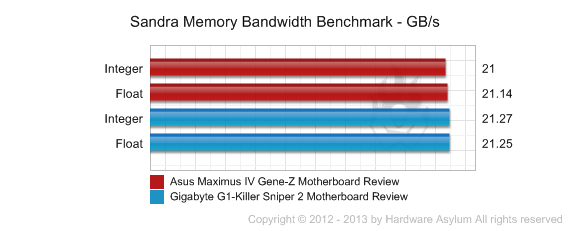Asus Maximus IV Gene-Z Motherboard Review
Author: Dennis Garcia
Published: Friday, September 02, 2011
Benchmarks - Synthetic
SiSoft Sandra
Sandra is a software collection of synthetic benchmarks that will give us a basic idea as to what a system is capable of. It should be noted that SiSoft numbers can change depending on what version you have installed; these were recorded using Sandra Professional Version 17.25.2011.1



RightMark Audio Analyzer
One of the most difficult things about doing reviews is finding some kind of common ground to establish a benchmark on so that when we say something is good our readers know it is based on something they can try themselves. In the case of audio reproduction there are too many factors to consider such as hearing quality, sound equipment (speakers) and room dimensions so we are turning to the RightMark Audio Analyzer to give us a set of audio specs. We will then use those numbers to determine what kind of audio quality you can expect.
This test was performed using a loopback cable which is basically a jack that connects the analog line-out plug back into the analog line-in. That way we can remove almost all of the variables and concentrate on what is actually being reproduced and recorded.
Specs
Frequency response (from 40 Hz to 15 kHz), dB: +0.06, -0.17
Noise level, dB (A): -88.5
Dynamic range, dB (A): 88.4
THD, %: 0.130
THD + Noise, dB (A): -52.8
IMD + Noise, %: 0.255
Stereo crosstalk, dB: -89.7
IMD at 10 kHz, %: 0.322
General performance Good
Color coding indicates good to bad, Bright green = Excellent - Bright Red = Poor - Black = Good
This test was performed using a loopback cable which is basically a jack that connects the analog line-out plug back into the analog line-in. That way we can remove almost all of the variables and concentrate on what is actually being reproduced and recorded.
Specs
Frequency response (from 40 Hz to 15 kHz), dB: +0.06, -0.17
Noise level, dB (A): -88.5
Dynamic range, dB (A): 88.4
THD, %: 0.130
THD + Noise, dB (A): -52.8
IMD + Noise, %: 0.255
Stereo crosstalk, dB: -89.7
IMD at 10 kHz, %: 0.322
General performance Good
Color coding indicates good to bad, Bright green = Excellent - Bright Red = Poor - Black = Good

Synthetic Conclusion
Synthetic performance never really tells the entire story, but is a good indication of what the system would probably be capable of doing under the right conditions. The Core i7 2600K is a very powerful processor despite only having a dual channel memory controller.
The new Rightmark audio benchmark is a great tool for exposing audio specs for the various chips and software used and read much like if you were buying an amplifier or sound system for your house. What you can take away from this is that the sound quality is "good" for an onboard audio solution. We did color code some of the other numbers to give you an indication as to what each of the numbers mean.
You may notice that the synthetic numbers are a little higher than the reference system(s) which is due to the default clock coming in at 3.8Ghz instead of the standard 3.5Ghz. It would appear that we have some factory overclocking in the default BIOS which isn't always a bad thing. This overclock does go away once you set the XMP memory profile, knowing this you can decide which is best for you.
We should also mention that the Rightmark audio specs go from Good to Poor when you enable the Creative audio driver. This is likely in response to what the software does to simulate the various effects that enhance our audio experience. The specs you see above were taken with the Creative effects disabled and actually turned out halfway decent.
The new Rightmark audio benchmark is a great tool for exposing audio specs for the various chips and software used and read much like if you were buying an amplifier or sound system for your house. What you can take away from this is that the sound quality is "good" for an onboard audio solution. We did color code some of the other numbers to give you an indication as to what each of the numbers mean.
You may notice that the synthetic numbers are a little higher than the reference system(s) which is due to the default clock coming in at 3.8Ghz instead of the standard 3.5Ghz. It would appear that we have some factory overclocking in the default BIOS which isn't always a bad thing. This overclock does go away once you set the XMP memory profile, knowing this you can decide which is best for you.
We should also mention that the Rightmark audio specs go from Good to Poor when you enable the Creative audio driver. This is likely in response to what the software does to simulate the various effects that enhance our audio experience. The specs you see above were taken with the Creative effects disabled and actually turned out halfway decent.

